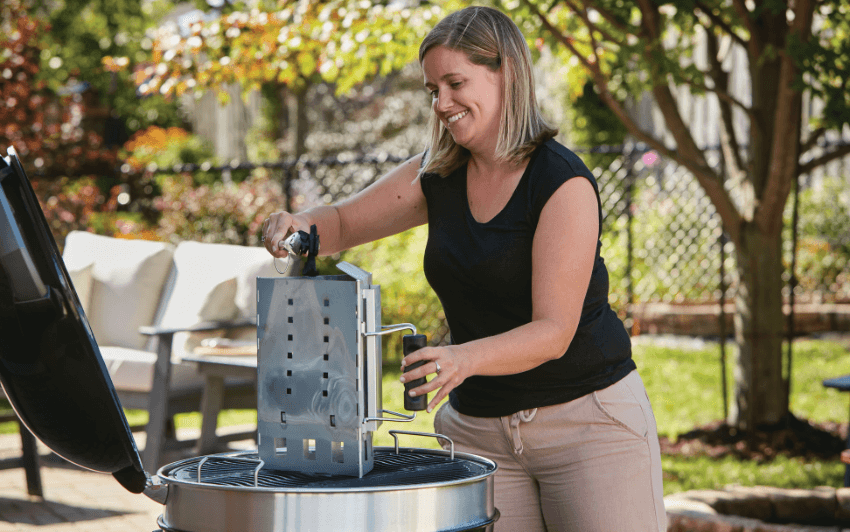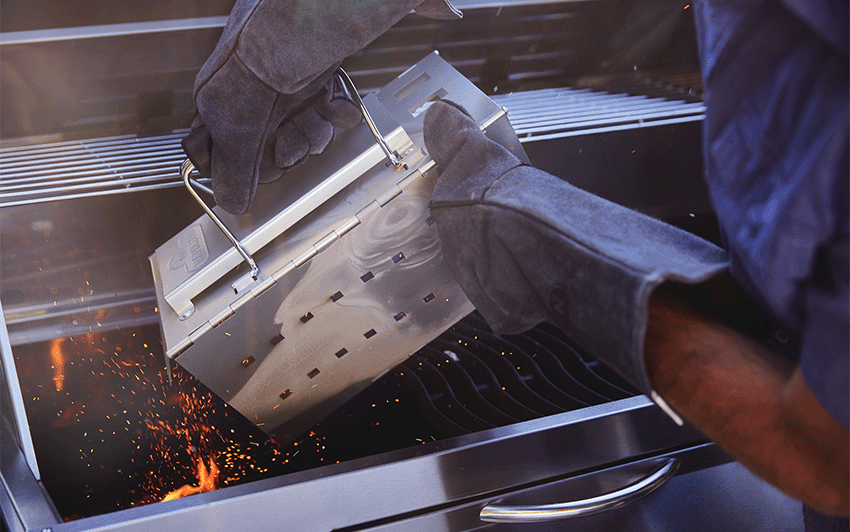
The Five Types of Charcoal and How to Choose Between Them
If you have a Napoleon charcoal or gas barbecue with the optional charcoal tray accessory, you’ll know that this traditional grilling method is an exciting way of enhancing the flavors of your food. Once the charcoal lights up, the signature aroma of barbecue rises to ignite your appetite.
While most of us have used charcoal at least once before, did you know that there are actually several types of charcoal to choose from? Let's explore the charcoal varieties that will help make your famous recipes shine!
What is Charcoal?
Charcoal is wood that has been stripped down to its most basic form, carbon. This happens by cooking the wood in a low-oxygen environment with extremely high temperatures for a few days. The lack of adequate oxygen levels prevents combustion, but it does burn off volatile compounds and organic matter, such as water, methane, hydrogen, and tar. When organic matter is removed, charcoal, or char, is what is left behind.
This process dates back about 30,000 years, and is still used today because, at its simplest form, charcoal burns steady, hot, cleaner, and more evenly than wood. Charcoal can be made from any species of wood, but alder, oak, and maple are the most common and are classified as hardwood, or “lump charcoal.”
The 5 Primary Types of Charcoal
Lump Charcoal
Lump charcoal responds exceptionally well to oxygen, which means that you can manipulate the vents on your charcoal grill to control the temperature in a short amount of time.
The downside is that they can be quite challenging to package, as the shapes are always irregular, resulting in a more complicated chimney-lighting experience, larger lumps of charcoal can also contain fragments of impurities that were not eliminated during the production process. Ultimately, this could result in cracking, sparks, and excessive smoke.
Charcoal Briquettes
Briquettes have been around since the 19th century. Thanks to easy accessibility, constant reliability, and how slowly they burn, charcoal briquettes are the most popular choices for barbecuers. This type of charcoal is produced by compressing wood scraps and sawdust together by means of binders, such as cornstarch.
Depending on the brand of briquette you choose to purchase, you may find that other additives are incorporated—in some cases, this could include limestone, used to ensure ash turns a pretty white color to signify readiness to cook, and Borax, which allows charcoal to release from the mold easier during manufacturing. However, there are 100% natural options available on the market today, and most brands need to meet strict quality control standards, ensuring that their charcoal briquettes contain more hardwood than soft.
Hardwood Briquettes
Hardwood briquettes are the same as charcoal briquettes, the only difference is that they are sorted to contain a higher ratio of hardwood scrap to softwood. Hardwood briquettes have immense staying power that give you the opportunity to cook low and slow while you socialize with your guests. It's a win-win situation! A bag of hardwood briquettes may cost a bit more than the standard briquettes, but you are bound to get your money's worth.
Coconut Charcoal (Shell and Briquettes)
Coconuts are some of the most useful fruits on the planet. From the coconut water and meat all the way to the husk or shell, no part of this thirst-quenching fruit goes to waste.
Coconut shell briquettes are made using a method that involves the burning and grinding of the shells and husks. Next, manufacturers add a slurry of cornstarch and water, and then press the mixture into a mold. In the final step, they are cut into briquettes in the shape of honeycomb or cubes.
For those who want to BBQ for longer hours, you can put your trust in coconut charcoal, as this fuel typically burns longer than charcoal made exclusively of wood. On the other hand, if you crave that iconic BBQ aroma, you won't find it in this fuel type. Additionally, coconut charcoal briquettes tend to be on the pricier side.
In a nutshell (or coconut shell, rather), their biggest edge over the competition is their lengthy burning power.
Binchotan Charcoal
Binchotan sits at the same table with charcoal briquettes, as it has been around for many years. In fact, binchotan has been around for several hundreds of years, and they are made through an extremely slow process that takes weeks to complete.
Binchotan is easily the most unique among all the types of charcoal. This type of charcoal is traditionally made from Japanese oak trees that were not logged, but instead, branches are selectively cut off leaving the tree alive and healthy. The magic happens in kilns, wherein the Japanese oak tree branches are burned at an extremely low temperature to reach optimal consistency. While authentic binchotan is rare, it's still a fantastic type of charcoal that gives you the opportunity to grill like a historian.
Grill Smoky and Aromatic Dishes with Charcoal
There’s nothing quite like the unmistakable smoky taste you get when grilling meat over a charcoal barbecue—so why not test your skills with one of the five types of charcoal listed in this blog? For premium charcoal grills and gas grills that can take on charcoal grilling, you can count on Napoleon. Our comprehensive barbecue and accessory collection is equipped with everything you need to get cooking!

